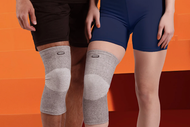Dive into our Bursitis 101 definitive guide and learn how to identify its telltale symptoms and tackle the pain with practical treatment tips.
Dive into our Bursitis 101 definitive guide and learn how to identify its telltale symptoms and tackle the pain with practical treatment tips.
Worried about the painful swelling of your bursa? Our Bursitis 101 guide will help you better understand the condition so you can quickly spot the signs and seek medical help before it turns chronic.
Over the next sections, we'll dissect everything you need to know, from its causes and symptoms to diagnosis, treatment, and steps to prevent it. Let's get into it.
Bursitis is an inflammation of the bursae - tiny, fluid-filled sacs that cushion your bones, tendons, and muscles near your joints. It results in pain and discomfort, particularly when moving or applying pressure.
Bursitis accounts for 0.4% of primary care clinic visits, though rates can vary based on factors such as age, occupation, and individual health conditions. It is more common in adults, especially those over the age of 40.
Bursitis is often triggered by repetitive motion or pressure, which irritates the bursae. Age, occupation, hobbies, and certain health conditions like diabetes and rheumatoid arthritis increase your risk of acquiring the condition.
Certain occupations or hobbies known to trigger bursitis include gardening, painting, carpentry, playing a musical instrument, and sitting on a hard surface for prolonged periods.
Bursitis can occur in various parts of the body. Some common types include:
Hip Bursitis: Caused by inflammation of the bursa located at the outer point of the hip. One of its most common subtypes is trochanteric bursitis, which occurs when one of the two bursae near the outer part of the hip becomes inflamed.
Shoulder Bursitis: Inflammation of the bursa in the shoulder can cause pain and restrict arm movements.
Elbow Bursitis: Occurs when the bursa of the elbow swells, leading to pain and limited movement.
Knee Bursitis: Characterized by inflammation in the bursa located near the kneecap. This type of bursitis often results in pain and swelling around the affected joint.
While the general symptoms of bursitis include aching, stiffness in the joint, pain during movement, redness, and swelling, particular symptoms can vary for each type of bursitis:
Hip Bursitis: Pain may extend to the buttocks or down the leg and worsen after prolonged sitting or walking.
Shoulder Bursitis: You may experience a dull ache, especially when you try to raise your arm.
Elbow Bursitis: The pain might increase when you bend your arm or lean on your elbow.
Knee Bursitis: Pain, warmth, and visible swelling on the knee are common indications.
Bursitis diagnosis begins with a visit to your healthcare provider. They will start by conducting a thorough review of your medical history and symptoms. Be prepared to answer questions about the type of pain you're experiencing, any activities that exacerbate your pain, and any measures you've taken to alleviate the pain.
The next step usually involves a physical examination, during which the doctor will apply pressure to the affected area and ask you to move your joint in various ways to check for pain and assess your range of motion. The tenderness directly over a swollen bursa usually indicates bursitis.
In some cases, further tests may be needed to confirm the diagnosis or to rule out other conditions. This might include:
Imaging Tests: X-rays can't visualize bursitis, but they can help to exclude other causes of your discomfort. Ultrasounds or MRIs (Magnetic Resonance Imaging) might be used if your doctor suspects a soft-tissue injury.
Lab Tests: If infection is suspected, your doctor may order blood tests or remove a small sample of the bursa fluid with a needle. These samples are sent to a lab for testing to determine if an infection or other condition is causing the inflammation.
Your doctor will analyze all these test results to create an effective treatment plan tailored to your specific condition.
The entire diagnosis procedure can last between 15 minutes to a few weeks, depending on factors like physical exam results or any pre-existing conditions like inflammatory arthritis, which may require further testing.
hip and knee bursitis
There are both non-invasive and invasive treatment options for minor and chronic bursitis.
These include taking ample rest, applying an ice pack to the affected area, and using over-the-counter anti-inflammatory medications such as ibuprofen. Physical therapy exercises can also help restore range of motion and strengthen the muscles around the joints.
For severe or persistent cases, your doctor might recommend steroid injections to reduce inflammation of the affected joint. As a last resort, a surgical procedure to remove the inflamed bursa may be required.
Using this option, the surgeon makes a small incision near the affected area and then removes or repairs the problematic bursa. This surgery can be performed using arthroscopy, a surgical procedure that allows the surgeon to look inside the joint using a small camera inserted through a small incision.
Commitment to lifestyle change is critical to prevent bursitis. Here are some practical tips to get you started:
Regular exercise to strengthen the muscles
Maintaining a healthy weight to reduce pressure on the joints
Taking breaks to prevent repetitive movement or pressure on a joint
Using paddings or protective gears like knee pads during physical activities
Wearing supportive footwear to lessen the impact on your joints
Understanding the cause and seeking prompt medical help is critical to prevent bursitis from escalating. With the right information and tools, you can take proactive steps towards pain relief and improved health.
Take the first step on your path to recovery! Check out our Thermo Recovery Wear collection for a natural solution to alleviating your chronic muscular and joint pain.

Incrediwear is on...
September 25, 24

Pain management i...
September 23, 24

Recovery wear is ...
September 12, 24